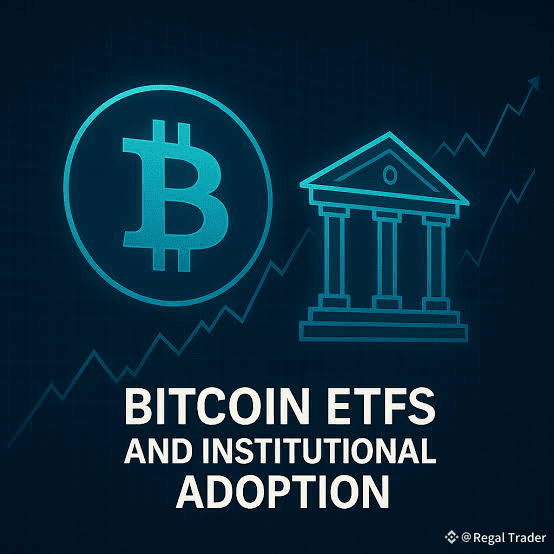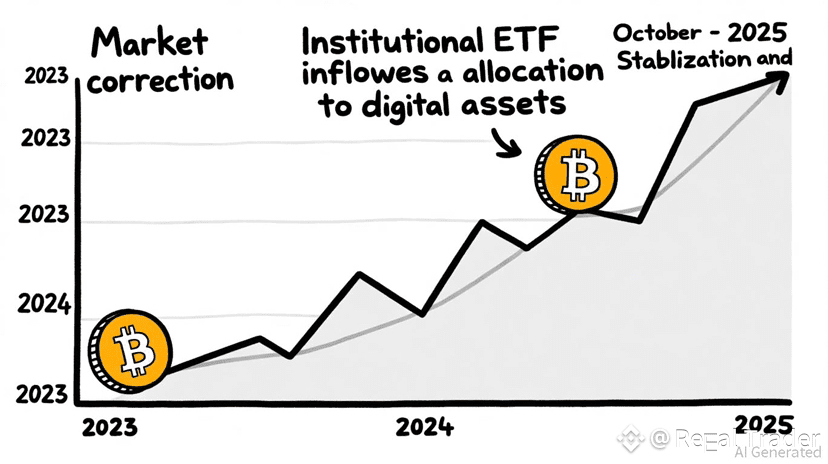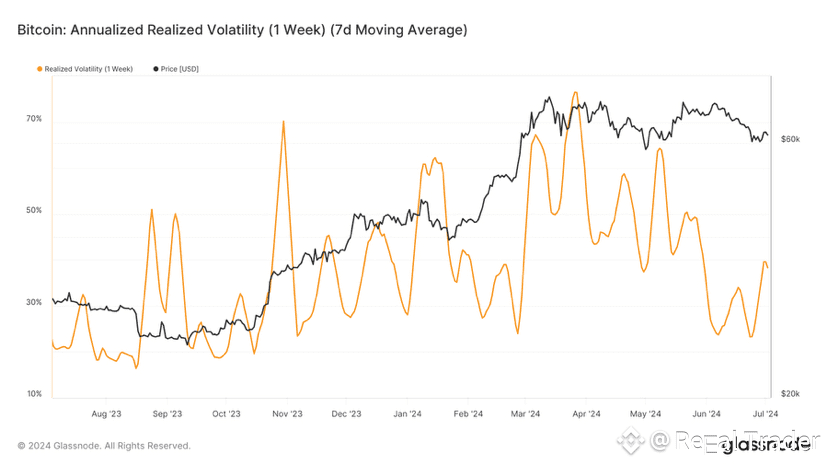Systemic Convergence:
 The first U.S. Spot Bitcoin Exchange-Traded Funds (ETFs) launch in early 2024 was more than a regulatory milestone; it was by far the most significant structural change event of Bitcoin's history. The story has moved beyond "access" to a deep Systemic Convergence of TradFi and digital assets. The ETFs have acted as a compliant vehicle for the inflow of institutional capital, with a total of more than $54 billion of net inflows since their inception, but their real power is in the deep rewrite of the market's liquidity, volatility profile, and price discovery mechanisms. This article goes through the three pivotal layers of this convergence: the quantum leap of capital, the institutionalization of arbitrage, and the resulting Bitcoin re-rating as a macro asset.
The first U.S. Spot Bitcoin Exchange-Traded Funds (ETFs) launch in early 2024 was more than a regulatory milestone; it was by far the most significant structural change event of Bitcoin's history. The story has moved beyond "access" to a deep Systemic Convergence of TradFi and digital assets. The ETFs have acted as a compliant vehicle for the inflow of institutional capital, with a total of more than $54 billion of net inflows since their inception, but their real power is in the deep rewrite of the market's liquidity, volatility profile, and price discovery mechanisms. This article goes through the three pivotal layers of this convergence: the quantum leap of capital, the institutionalization of arbitrage, and the resulting Bitcoin re-rating as a macro asset.
I. The Quantum Leap in Capital: Velocity and Scale
The spot Bitcoin ETFs could not have been more successful. For example, BlackRock's iShares Bitcoin Trust (IBIT) was identified as the most successful ETF launch in history by the amount of assets gathered in the first year. These inflows are far beyond mere retail enthusiasm; they are indicative of a blocked demand for professional money managers, endowments, and RIA platforms that were previously either directly or non-compliantly exposed.
Key Institutional Data Points (Q3/Q4 2025):
• Flow Momentum: These funds have experienced several months with net inflows exceeding $4 billion, which shows a strong and sustained investor conviction.
• The Hedge Fund Pivot: Form 13F filings reveal that a large number of billionaire-led hedge funds and major asset managers have not only taken positions but in many cases considered Bitcoin as a vital hedge against fiat debasement and geopolitical uncertainty.
• Forward-Looking Commitment: Surveys show that 59% of institutional investors are willing to increase their digital asset allocations within the next three years thus making Bitcoin a permanent portfolio component.
The ETF format—giving the features of easy tax reporting, professional custody, and trading within normal brokerage accounts—essentially took away the "operational friction" that had kept digital assets in a kind of glass box away from multi-trillion-dollar institutional balance sheets.
II. Decoding the Institutional Arbitrage Play: The NAV Fixing Window
The most convincing feature of the institutional command is the considerable shifting of Bitcoin’s trading hours and liquidity volume. This change is the introduction of a brand new and very specific institutional mechanism at the core of crypto price discovery: The NAV Fixing Window.
Before the introduction of the ETFs, Bitcoin trading was very decentralized and happened on various exchanges worldwide. Now it is highly concentrated with a 38% move to US market hours, and the peak is very precisely between 3:00 PM and 4:00 PM New York Time (NYT) for trading volume.
The Mechanics of Institutional Price Discovery:
1. Arbitrage Dependence: Sophisticated arbitrage funds account for up to 66% of ETF flows. These funds take advantage of minor price differences between the ETF market price and the underlying Net Asset Value (NAV).
2. Authorized Participant (AP) Activity: To keep the ETF share price close to the NAV, APs are always creating and redeeming shares. When they do creation, they need to buy spot BTC; on the other hand, if it is a redemption, they will sell.
3. The Fixing Nexus: The NAV is based on regulated benchmarks (e.g. the CME CF Bitcoin Reference Rate) that consider price data from a limited number of compliant exchanges (e.g., Coinbase, Kraken) during the 3 PM to 4 PM NYT window. The huge volume burst that results from APs and market makers finishing their trades before the day's NAV is done has turned this hour into the market's new center for price confirmation and liquidity injection.
This systemic evolution brings Bitcoin price setting closer to the level of regular stock and commodity markets which means it is fully integrated into the global financial plumbing.
III. The Maturation of Volatility and Macro Re-Rating
The introduction of institutional capital regulated by market structures has had a direct, measurable impact on Bitcoin's risk profile. It has been moved from a device for high-beta speculation to a more mature, risk-managed asset class.
The era after ETF has seen the average daily volatility of Bitcoin actually halving from the pre-ETF high of around 4.2% to a current range of about 1.8%. Such an extraordinary decrease is no coincidence; it is the direct result of large-scale, professional hedging and the continuous, stabilizing role of the ETF creation/redemption mechanism.
Bitcoin's New Macro Identity:
The transition of institutional investors is also bringing about a change in the way Bitcoin is viewed by macro portfolios. One of the most common shifts we see is the "Gold-to-Bitcoin" rotation, where the capital moves from physical gold and gold ETFs to Bitcoin ETFs.
• Digital Gold 2.0: While Gold (XAU) has been the main hedge against fiat instability traditionally, due to Bitcoin's better transportability, divisibility, and provable scarcity it is being set up as the most likely next generation store of value for big institutions that have to deal with complex macroeconomic scenarios.
• Hedge Against Sovereign Risk: The correlation data that presently reveals a moderate positive relationship with the S&P 500 might be hiding the real long-term thesis. For institutional allocators, Bitcoin is a non-sovereign, non-credit-risk asset, thus a very important diversification layer in the situation of high national debt and continuous inflation risk.
Conclusion: The Path to Trillion-Dollar Integration
The Bitcoin ETF stands as more than a single product; it is the driving force behind the digital asset ecosystem becoming a permanent part of the industrialized world. It is an endorsement of the asset class, it lessens its risk profile, and it guarantees that its expansion is backed by the strongest financial infrastructure in the world.
The subsequent evolutionary stage will be about achieving similar success with other compliant digital assets. For example, potential approval of staking-enabled Ethereum ETFs and other crypto-adjacent products in 2026 will be the next step in deepening the integration. Institutional demand is not merely a goal for Bitcoin anymore; it is the main driver of its systemic relevance.
